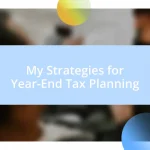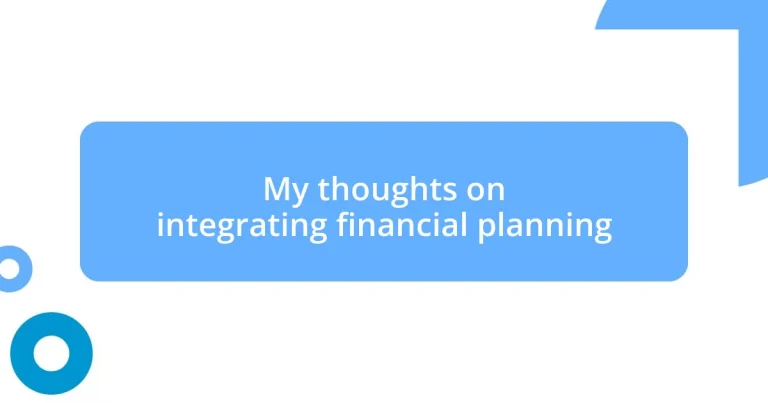Key takeaways:
- Financial planning provides peace of mind and helps alleviate anxiety about unexpected expenses.
- Identifying and categorizing financial goals clarifies priorities and motivates better financial decisions.
- Creating a structured financial plan involves defining goals, establishing timelines, and tracking progress regularly.
- Leveraging professional financial advice can enhance understanding and confidence in managing finances, leading to more informed decisions.
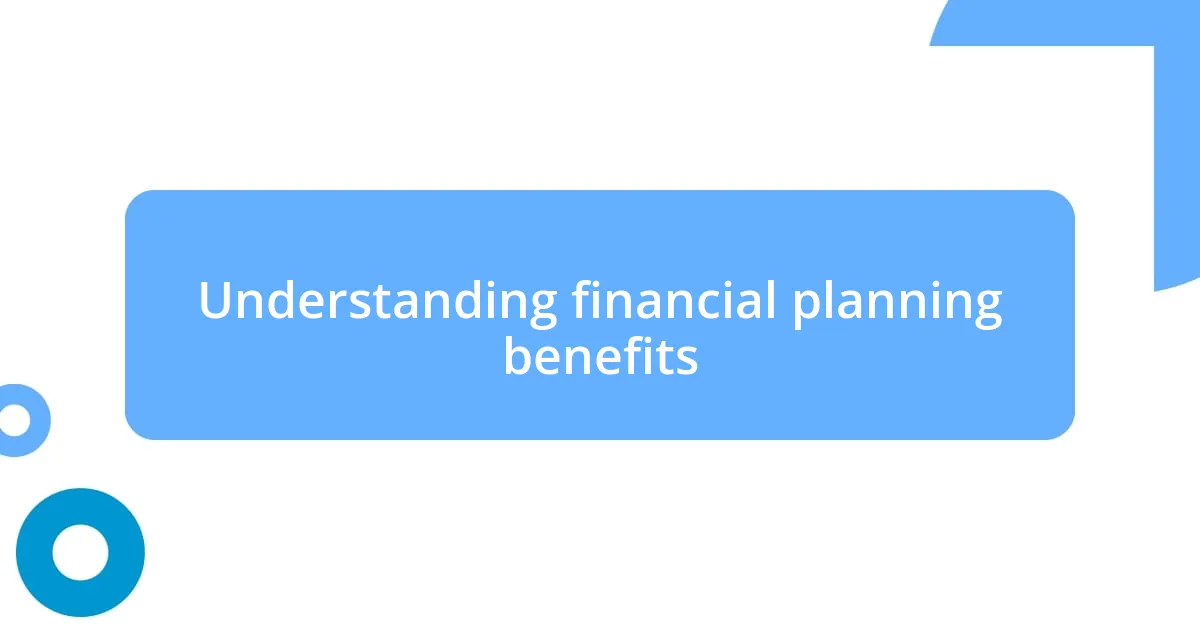
Understanding financial planning benefits
Financial planning offers a roadmap for achieving your life goals, which can often feel overwhelming. I remember when I first sat down to create a budget; it was both intimidating and liberating. Seeing everything laid out clearly helped me realize my priorities, and suddenly, I had a tangible plan to work toward my dreams, like that vacation I had always wanted.
One significant benefit of financial planning is the peace of mind it brings. Personally, the anxiety of not knowing if I could cover unexpected expenses used to haunt me. When I started putting a financial plan in place, I felt a weight lift off my shoulders. I could finally sleep at night, knowing I had a safety net to fall back on.
Moreover, financial planning fosters better decision-making. Have you ever felt paralyzed by choices? I’ve been there. When I integrated financial planning into my life, each financial decision became less daunting. Instead of impulsively splurging on something, I could weigh my options against my overall goals, turning a moment of uncertainty into empowerment.
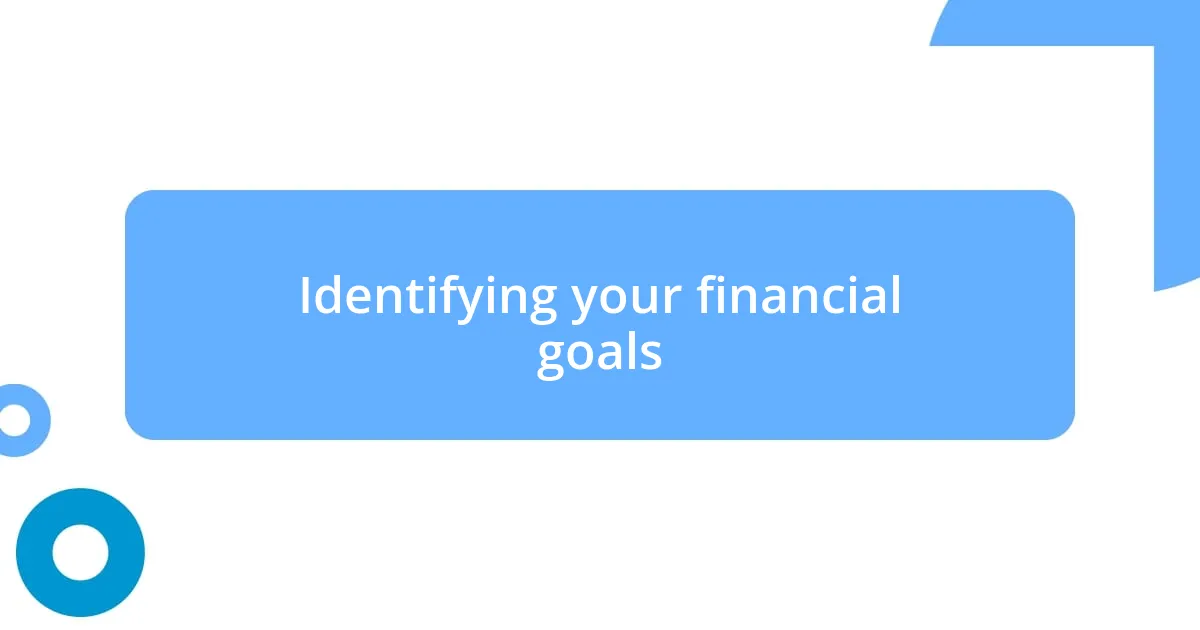
Identifying your financial goals
Identifying your financial goals is the cornerstone of any effective financial plan. I remember when I first outlined my goals; it was a revealing experience that forced me to confront my values and aspirations. By clarifying what truly mattered—like saving for a home or funding my children’s education—I transformed nebulous dreams into clear targets that motivated my financial decisions.
To help you pinpoint your own financial goals, consider these aspects:
- Short-term goals: Debts to pay off, a vacation, or building an emergency fund.
- Medium-term goals: Saving for a car, further education, or a home down payment.
- Long-term goals: Retirement planning or investing in a dream business.
- Personal values: What experiences or security mean the most to you?
- Timeframe: How urgent are these goals? Differentiating between immediate, medium, and long-term aspirations can guide your planning effectively.
Once I broke my own goals down into these categories, I found it easier to prioritize my spending and savings. It was eye-opening to see how aligning my finances with my true desires made managing my money more rewarding and less stressful.
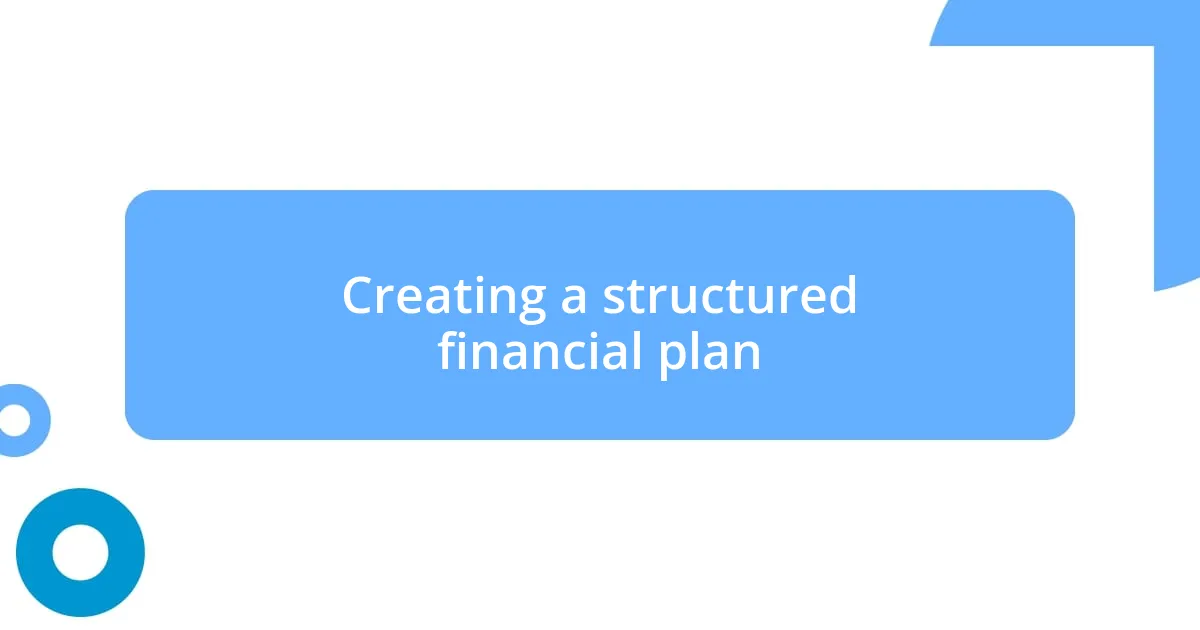
Creating a structured financial plan
Creating a structured financial plan is more than just numbers on a page; it’s an emotional journey. When I first structured my financial plan, I felt a mix of excitement and trepidation. I began by mapping out not only my income and expenses but also the emotional significance behind each category. By doing this, I was able to prioritize what truly mattered to me, turning cold data into a vibrant picture of my financial future.
The next step in structuring my plan involved creating a timeline. I recall sitting with a calendar, feeling overwhelmed but energized as I established deadlines for my goals. This act of visualizing my progress was like having a checklist for my dreams. It transformed abstract ideas into achievable milestones, making each step feel rewarding. Seeing my goals laid out over time helped cultivate a sense of accountability.
Finally, tracking my financial progress became essential. I remember the rush of checking off a savings target, which felt like little victories along the way. Establishing regular reviews allowed me to fine-tune my plan and shift gears when needed. This iterative process kept me engaged and motivated; it felt less like a chore and more like a journey, allowing me to adjust my sails when the winds of life change direction.
| Step | Description |
|---|---|
| Define Your Goals | Establish specific financial goals based on personal values and aspirations. |
| Create a Timeline | Visualize your goals over a specified timeframe to establish urgency and accountability. |
| Track Progress | Regularly review your financial situation and adjust your plan as necessary. |
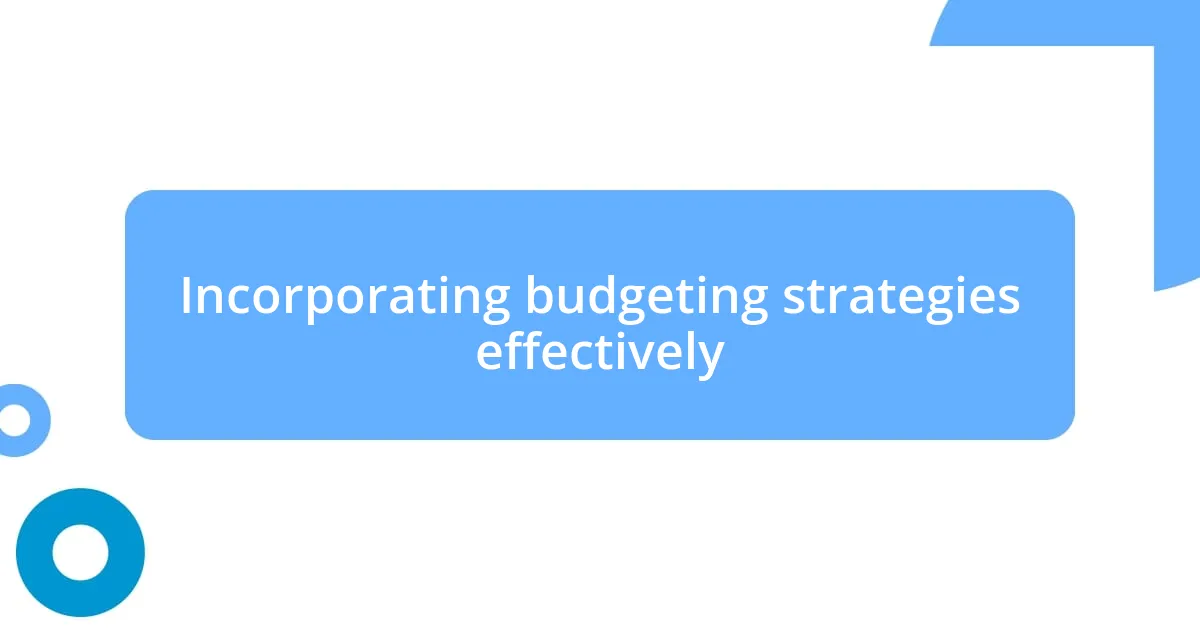
Incorporating budgeting strategies effectively
In my experience, incorporating effective budgeting strategies involves a balance between discipline and flexibility. I vividly recall a time when I allocated a set amount for entertainment each month, only to realize that my love for spontaneous outings was clashing with my budget. By adjusting my approach and allowing for a little wiggle room, I not only stayed within my financial limits but also enjoyed life more fully. Is it possible to stick to a budget while still having fun? Absolutely! The key lies in finding that sweet spot where your budget reflects your lifestyle.
Another tactic I found immensely helpful is the 50/30/20 rule: 50% for needs, 30% for wants, and 20% for savings or debt repayment. When I first applied this rule, it felt surprisingly liberating. I was able to enjoy little luxuries without the guilt, all while ensuring I was saving for my future. Has anyone else felt that budgeting can sometimes feel like a straitjacket? By using this flexible framework, I transformed my mindset from restriction to empowerment, making budgeting feel like a positive choice rather than a chore.
Finally, automating my savings was a game changer. Once I set up automatic transfers to my savings account, I no longer had to rely on willpower alone to save. I remember the thrill of seeing my savings grow effortlessly, turning what once felt daunting into a seamless process. Why complicate things when you can simplify your life? By prioritizing budgeting strategies that align with my goals, I found not just financial stability, but genuine peace of mind—an invaluable benefit for any planner.
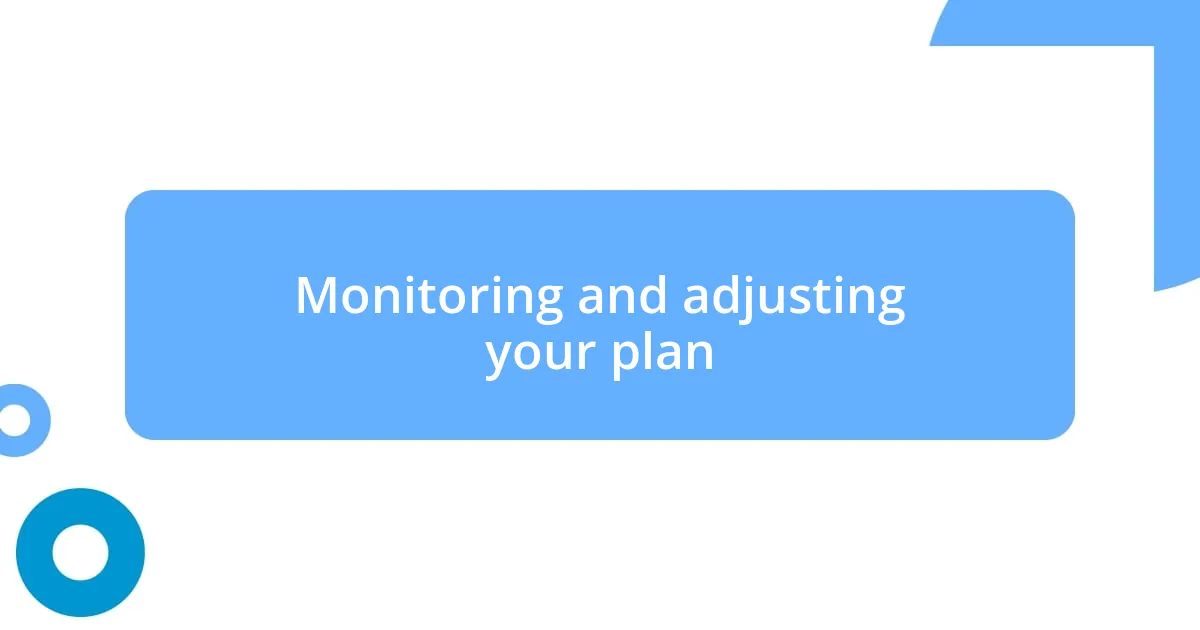
Monitoring and adjusting your plan
As I delved deeper into my financial journey, I quickly realized that monitoring and adjusting my plan was not just a periodic task; it became a vital routine that shaped my path. I remember the first time I sat down to review my budget—my heart raced as I analyzed the numbers, half-expecting to discover that I’d overspent. Instead, I was pleasantly surprised to find areas where I could cut back, and that sense of control felt empowering. Isn’t it interesting how regular check-ins can transform anxiety into confidence?
Adjusting my financial plan became almost second nature after a few months. I made it a point to revisit my goals every quarter, reflecting on what motivated my choices. There was a moment when I had to reassess my savings goal for a trip I had been dreaming about. I hesitated at first, worried I might lose sight of that aspiration, but I soon realized that recalibrating the timeline did not mean giving up. Instead, it meant prioritizing my current needs without sacrificing future dreams. Have you ever had to shift your focus on a goal? It’s a testament to our growth.
On one occasion, a job change came with unexpected costs, and my initial reaction was panic. But that moment forced me to dig into my plan in a way I hadn’t before. I systematically re-evaluated my spending habits and revised my budget. Feeling the relief of adjusting my plan gave me a renewed sense of purpose. It taught me the importance of adaptability; after all, isn’t financial planning about more than just sticking to a perfect path? It’s about navigating the landscape of life, adjusting as necessary, and enjoying the ride.
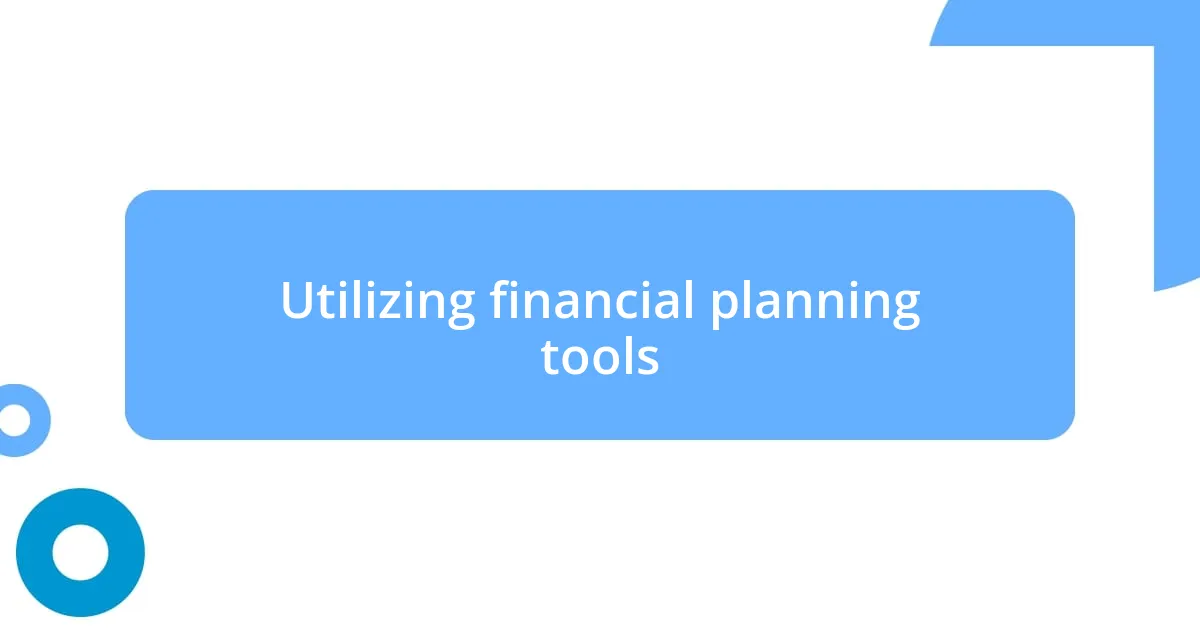
Utilizing financial planning tools
Utilizing financial planning tools can feel like discovering a treasure chest filled with resources that can simplify your financial life. I remember when I first started using budgeting software; it felt like I had a personal financial advisor right at my fingertips. These tools not only help visualize expenses but also allow me to set clear, achievable goals. Have you ever had that moment of clarity when all the numbers just click into place? It’s exhilarating!
What I cherish about financial planning tools is their ability to keep me accountable. There were times when I wanted to forgo my savings plan after a long week, thinking, “Just this once won’t hurt.” But the notifications reminding me of my savings milestones helped me refocus and stay committed. Those little nudges function like a gentle push in the right direction. Do you find it easy to stick to your plans without reminders, or do tools act as your guiding stars?
Furthermore, I’ve found that visualization features in some apps make all the difference. When I designed my long-term financial trajectory, seeing progress bars and graphs made my aspirations feel tangible. I vividly recall the thrill of watching those bars fill up over time—it ignited a sense of accomplishment that kept me motivated. Isn’t it fascinating how seeing progress in black and white can change your entire perspective on your financial journey? By integrating these tools into my planning, I’ve transformed what was once a daunting task into an engaging adventure, with each tool as a companion along the way.
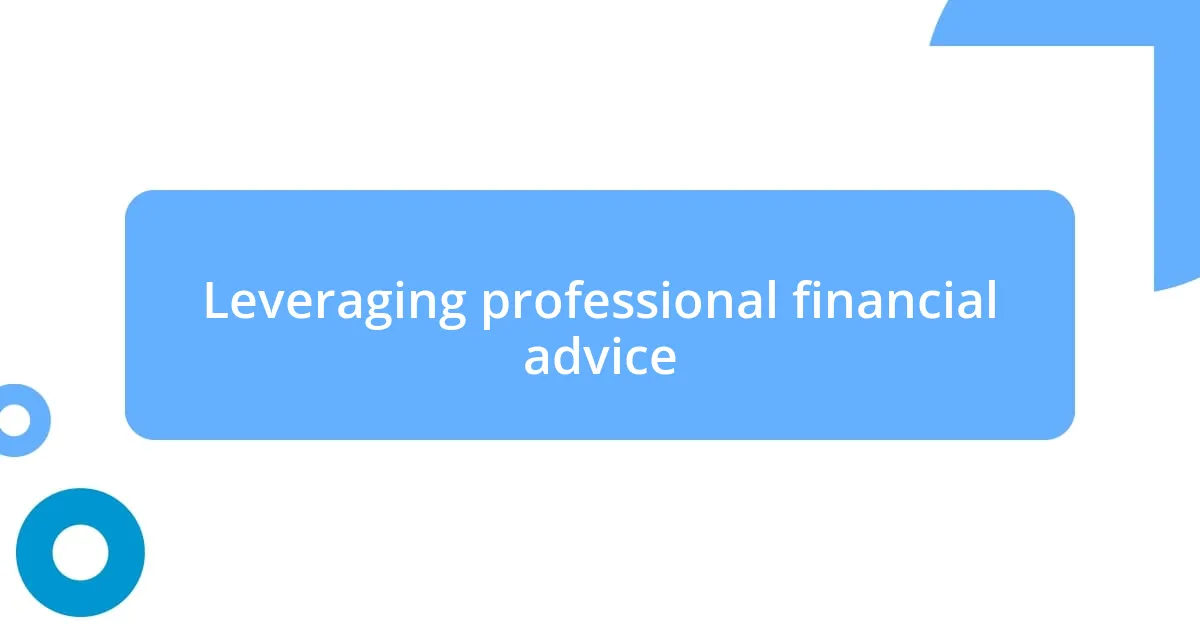
Leveraging professional financial advice
Leveraging professional financial advice can be a game-changer in your financial journey. I still remember reaching out to a financial advisor for the first time; it was a bit intimidating but overwhelmingly empowering. The insights they provided around investment options and tax strategies were things I never would have considered on my own. Have you ever felt lost in a sea of financial jargon? A good advisor can help demystify that for you, breaking down complex concepts into actionable steps.
What truly struck me was the personalized approach they took in aligning strategies with my unique goals. I vividly recall a conversation about retirement planning where they asked me not just about my numbers but my dreams. Suddenly, the conversation shifted from mere calculations to a vision of my future. It made me realize that financial advice is not just about strategies; it’s about shaping your life in a way that resonates deeply with who you are. Have you had similar experiences in working with a professional who genuinely connects with your goals?
As I continued to engage with my advisor, I saw the transformative power of having an expert in my corner. There was a significant moment when they encouraged me to diversify my investments—something I was hesitant about due to fear of risk. The advisor helped me navigate my apprehension, explaining the balance between risk and reward. That guidance expanded my horizons significantly. Isn’t it remarkable how a trusted expert can inspire confidence in steps you might otherwise avoid? I’ve built a relationship based on trust, which has not only refined my financial strategies but enriched my overall outlook on financial planning.









